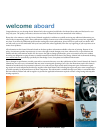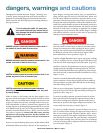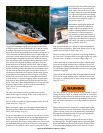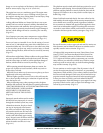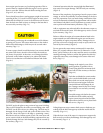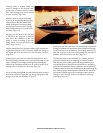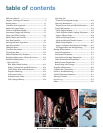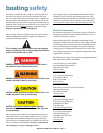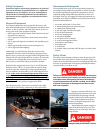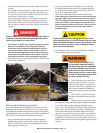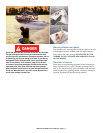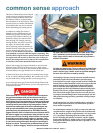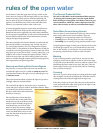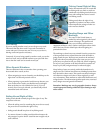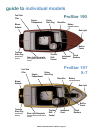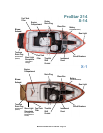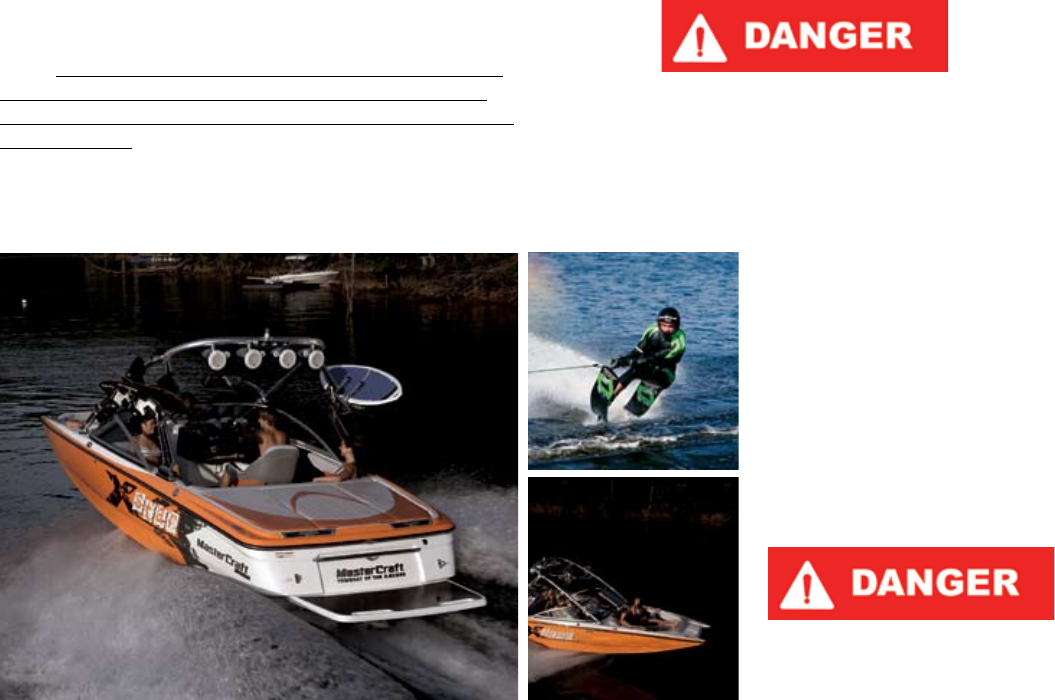
Safety Equipment
Federal law requires certain safety equipment to be on-board
your boat at all times. Responsible boaters carry additional
equipment in case of emergency. It is your responsibility to
check with the local boating authorities for any additional
requirements and/or equipment over and above the federal
requirements.
Required Equipment
Your MasterCra boat has been equipped at the factory with
most of the federally required safety equipment for inland waters
(Class I, 16-foot-to-26-foot watercra, and Class II, 26-foot-to-
40-foot watercra). is equipment includes:
• ABYC-approved (American Boat & Yacht Club) marine muf-
ers with water injection;
• USCG-approved (United States Coast Guard) marine ame
arrestor;
• USCG-approved engine box ventilation with sparkless power
blower;
• ABYC-approved electric horn sound-warning device;
• USCG-approved inland lighting.
Additionally, you should always check that you have a re
extinguisher on board, which is mandatory equipment. If you
desire to do so, you may buy an approved re extinguisher from
MasterCra as an optional purchase for your boat. If you decide
to purchase a re extinguisher from an outside source, verify
that it meets or exceeds the federal performance mandate.
Federal law also requires at least one Type I, II or III Personal
Flotation Device (“PFD”), for each person on-board or being
towed on water skis, wakeboards or other recreational equip-
ment. In addition, one throwable Type IV PFD must also be on
board. As the owner, obtaining the appropriate PFDs is your
responsibility and determining whether people on-board ,
including those who are underage, are required to wear PFDs
when underway. Your MasterCra dealer can, and will be happy
to, assist you with your purchase of appropriate PFDs.
Note: Requirements for coastal waters and inland waters dier.
Check with the local boating authorities for more information.
Recommended Equipment
e responsible boat owner will avoid potential problems on
an outing by having additional equipment on board. Normally,
the decision regarding the appropriate equipment to take on
individual outings is dependent upon the body of water and
the length of the trip. We suggest the following equipment as a
minimum (your MasterCra dealer can also assist you with ad-
ditional recommendations):
• An anchor with at least 75 feet of line;
• A manual bailing device for removing water;
• A combination oar/boat hook;
• A day-and-night visual distress signal;
• A rst aid kit and manual;
• An airway breathing tube;
• A waterproof ashlight;
• A non-electric horn or whistle;
• A set of local navigational charts;
• Mooring lines and fenders;
• Extra engine oil;
• A tool kit; and
• A portable, battery-operated AM/FM radio or weather radio/
scanner.
Safety Afloat
e cause of many boating accidents is oen the operator’s fail-
ure to follow basic safety rules or written precautions. Many ac-
cidents can be avoided if the operator is completely familiar with
the boat, its operation and can recognize potentially hazardous
situations before an accident occurs.
Failure to comply with safety-related information and instructions
may result in serious injury or death to you and/or others. Always
use common sense when operating the boat or participating in
any activities associated with the boat, including, but not limited
to, periods of time when the boat engine is shut down and the
boat is not in operation.
• Improper operation of the boat is ex-
tremely dangerous! Operators must read
and understand all operating manuals
supplied with the boat, before operation.
• On-board equipment must always
conform to the governing federal, state
and local regulations.
• Always attach the engine emergency
safety shut-o lanyard to a part of your
clothing (such as a belt loop) when oper-
ating the boat.
Never override or modify the engine
emergency safety shut-off switch in any way.
MasterCraft 2009 Owner’s Manual - Page 1-2



